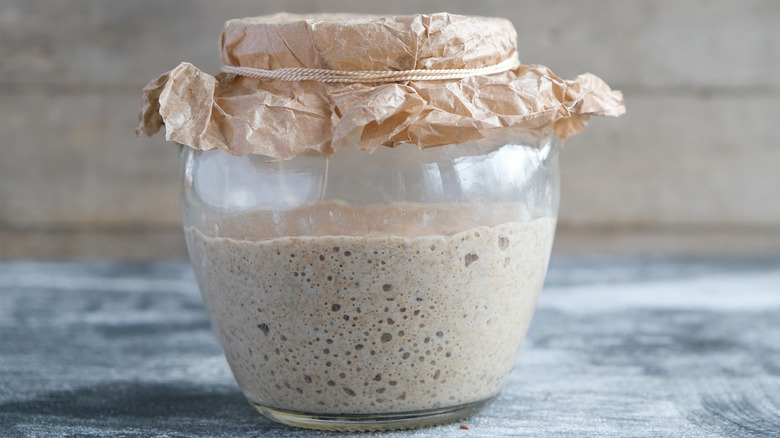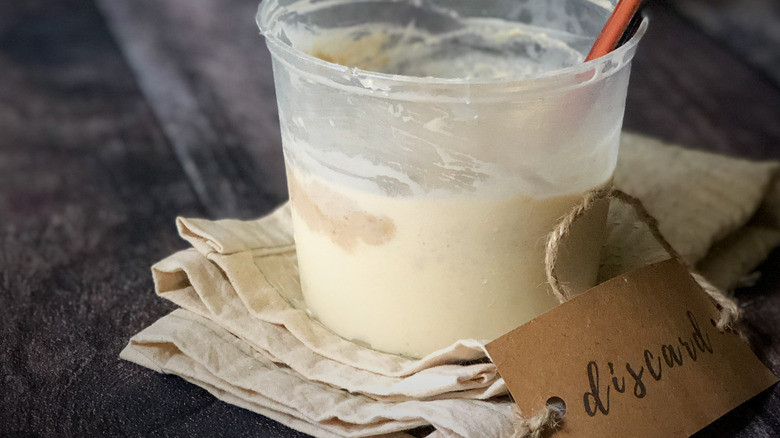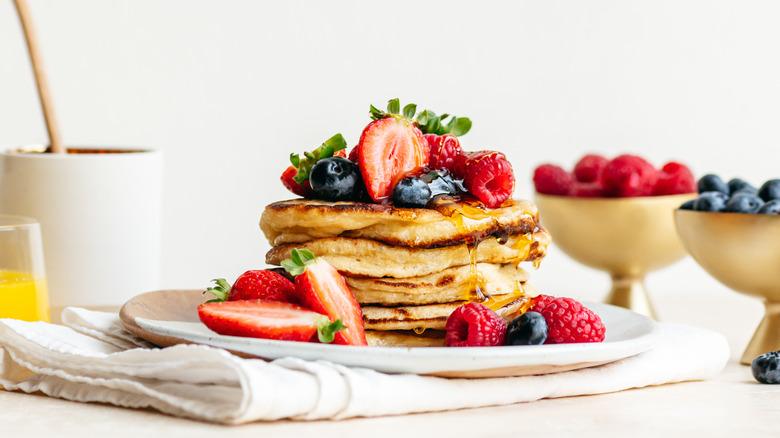Should You Store Your Sourdough Discard In The Fridge?
Sourdough starters have been utilized for centuries, and experienced a surge in popularity among home bakers a few years ago when commercial yeast was scarce. Many of us transformed our kitchens into veritable science labs, fermenting flour and water to cultivate a living, breathing culture that naturally leavens bread (reminiscent of Victor Frankenstein). Though commercial yeast is readily available again, some people fell in love with sourdough's distinctive taste and texture, vowing to keep their starters alive.
Depending on how often you bake, you should feed your sourdough starter with additional flour and water daily, or at least weekly. Given that its volume doubles with each feeding, it's crucial to remove or "discard" a portion of the unfed starter to avoid ending up with an oversized batch. Rather than throwing it away, however, sourdough discard can repurposed in both sweet and savory recipes, which typically require ½ to one cup of this valuable substance to enhance the flavor and texture of baked goods.
If you find yourself with excess discard and no immediate plans to bake, you can store the unfed starter in the refrigerator for up to one week, continuously adding more to the container as needed. The discard may develop a grayish liquid on top, known as "hooch," which is an alcoholic byproduct indicating that the yeast is becoming dormant. This is entirely normal and safe to use. You can stir the hooch back into the discard for a tangier flavor, or pour it off if preferred.
Tips for using sourdough discard
Sourdough discard should not be seen as waste, but rather as a valuable ingredient that adds tenderness and flavor to sweet and savory dishes beyond just bread. It is removed from the starter before a regular feeding, meaning the discard is too weak to act as a leavening agent (replacing yeast, baking powder, or baking soda), and can thus be incorporated into a broader range of recipes. Starters fed with high-protein flour, such as all-purpose or bread flour, will be more active than those fed with cake flour. However, the unfed discard is less active, exhibiting few, if any, bubbles on its surface.
Over time, as your sourdough matures, its discard becomes more acidic. This lower pH level in baking restricts gluten strand formation, resulting in softer and more tender baked goods. While gluten development is desirable for chewy bagels and springy noodles, limiting it benefits the texture of delicate cakes and cookies. In small quantities, the tangy flavor of sourdough discard can counterbalance the sweetness in desserts. You can incorporate up to ⅔ cup of discard in your recipes to enjoy its advantages without overwhelming your palate with sourness. As an added bonus, using sourdough discard can extend the freshness of baked goods, allowing you an extra day to polish off that tray of brownies.
Recipes using sourdough discard
If you've just created your sourdough starter, wait until it's active enough to double in size before using the discard. The time this takes can vary, depending on the environment and the starter's "diet," and may last a week or longer. You can use mature sourdough discard in recipes that include flour and water, such as muffins, pancakes, brownies, and cookies. There are recipes available that have already made the necessary adjustments, like our fermented kefir pretzel recipe, or you can adapt one of your family favorites by doing a bit of math.
To make the substitution, subtract a percentage of flour and water from the OG recipe. Please note that it's crucial not to replace fats like oil or milk with discard, as this will impact the texture. Since sourdough discard is measured by weight and not volume, you'll need to convert measurements from cups to ounces or grams, and use a kitchen scale.
Start by weighing your sourdough discard. To keep the dish's texture and structure intact, replace no more than ⅓ of the recipe's flour with the discard. Divide the discard's weight by two, and subtract that amount from both the flour and liquid in the recipe, updating the measurements accordingly. When you prepare the dish, add the adjusted amounts of flour and liquid along with the sourdough discard as directed in the recipe. There's no need to change any other ingredient or the cooking time, as this substitution maintains the original hydration level.



